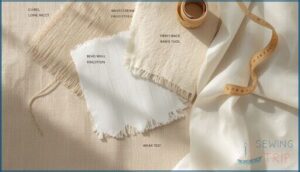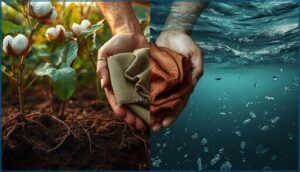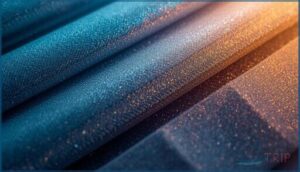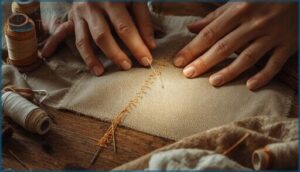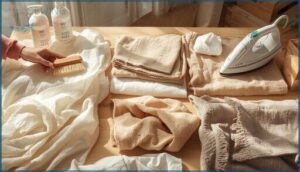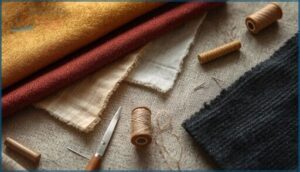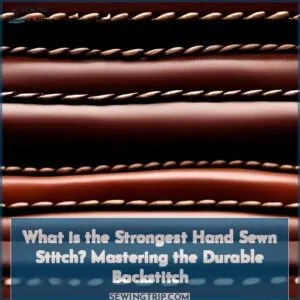This site is supported by our readers. We may earn a commission, at no cost to you, if you purchase through links.
You’ve probably invested time and money into a beautiful piece of fabric, only to watch it pill, fade, or lose its shape after a few washes. The frustration is real—and it’s often preventable. The truth is that fabric durability isn’t just about luck or the price tag. It depends on specific qualities you can actually evaluate and understand: the fiber type, how tightly the threads are woven, the weight and structure of the material, and the treatments applied during manufacturing.
When you know what to look for and how to care for your finished garments, you stop treating durability as a mystery. Instead, you gain the confidence to choose fabrics that will last, sew them correctly, and maintain them properly. The difference between a garment that falls apart in a season and one that becomes a reliable favorite often comes down to these deliberate choices.
Table Of Contents
- Key Takeaways
- Factors Influencing Fabric Durability
- Natural Vs. Synthetic Fabrics
- Advanced Fabric Technologies
- Choosing Fabrics for Long-Lasting Garments
- Sewing Techniques for Enhanced Durability
- Fabric Care and Maintenance Essentials
- Troubleshooting Common Fabric Issues
- Frequently Asked Questions (FAQs)
- Conclusion
Key Takeaways
- Fabric durability depends on specific measurable qualities—fiber type, weave tightness, weight, and manufacturing treatments—rather than price or luck, giving you concrete factors to evaluate before purchasing.
- Synthetic fibers like nylon and polyester offer roughly double the tensile strength of natural fibers like cotton, but blended fabrics combine natural comfort with synthetic resilience to balance durability and wearability.
- Your sewing techniques matter as much as fabric choice: using proper stitch density (6 stitches per centimeter), matching grainlines, and reinforcing seams directly determines whether garments last a season or years.
- Washing less frequently (every 30+ wears), using cold water with gentle detergent, air drying, and addressing small damage immediately can extend your garment’s lifespan by up to 4.8 years.
Factors Influencing Fabric Durability
When you’re choosing fabric for a project, durability isn’t just about picking something that feels sturdy in your hand. Several key factors work together to determine how well a fabric will hold up over time, from everyday wear to repeated washing. Understanding these elements helps you make smarter choices before you even thread your needle.
Fiber Type and Strength
Fiber tenacity matters when you’re choosing fabric. Natural fibers like cotton offer moderate tensile strength around 3–4 grams per denier, while synthetics bring synthetic superiority—nylon and polyester deliver roughly double that force.
Fiber structure, length, and cohesion influence how well your garment holds up under stress. Understanding fiber properties and fiber types helps you match material strength to your project’s demands before you start sewing.
To assess a fabric’s robustness, consider its tensile strength properties.
Weave Patterns and Density
Once you understand fiber strength, weave patterns and durability become your next consideration. A tight weave locks yarns together, boosting abrasion resistance—tightly woven upholstery fabrics exceed 40,000 Martindale cycles, while loose weaves fail before 20,000. Higher thread count raises tensile strength by roughly 20% and improves shrinkage control, though denser weave structure also increases fabric mass. Weave stability directly determines how long your garment lasts. The Martindale test method simulates friction from actual use.
- Plain weaves offer maximum yarn interlacement and surface uniformity
- Twill patterns balance strength with drape through diagonal floats
- Satin structures sacrifice some durability for smoother surface appeal
Fabric Weight and Thickness
Weight and density work hand-in-hand with weave structure. GSM explained: grams per square meter measure fabric mass—lightweight garment fabrics run 70–150 GSM, midweight 150–250, heavyweight above 250.
Fabric weight affects both durability and comfort factors. Denim at 300–450 GSM delivers longevity selection for workwear, while 180–230 GSM suiting balances fabric stability with seasonal appropriateness.
Heavier fabrics resist wrinkles and maintain shape better than ultralight alternatives.
Abrasion and Tear Resistance
Beyond weight itself, abrasion resistance and tear resistance determine how fabrics survive real-world friction. Martindale testing measures rubbing endurance—heavy-use garments target 20,000–30,000 cycles, while workwear often exceeds 40,000.
The Elmendorf method quantifies tear strength, showing woven fabric construction outperforms knits due to interlaced stability.
Coating impact and performance benchmarks guide your textile strength choices, ensuring wear resistance matches your project’s demands.
Colorfastness and Finish Treatments
Dye types and fabric finishes directly shape how well your sewn pieces hold their color and withstand repeated care cycles. Standardized tests like ISO 105 series measure colorfastness to light, laundering, and perspiration—essential durability interactions that predict long-term performance.
- Reactive dyes form covalent bonds with cotton, delivering excellent wash and rub fastness ratings of 4–5
- Chemical treatments such as elasticity finishes improve wool’s dimensional stability while affecting abrasion cycles
- UV protection and antimicrobial finishes extend garment lifespan by reducing photodegradation and surface wear
Natural Vs. Synthetic Fabrics
When you’re choosing fabric for a project, understanding the difference between natural and synthetic materials helps you make smarter decisions about durability and care. Each fiber type brings its own strengths to the table, from cotton’s breathability to nylon’s tear resistance.
Let’s break down how these fabrics perform and what makes each one worth considering for your next sewing project.
Durability of Cotton, Linen, Wool, and Silk
Natural fibers each bring distinct strengths to your sewing projects. Linen’s tensile strength outpaces cotton by roughly 25%, and its abrasion resistance reaches 10,000–15,000 Martindale rub cycles—enough for years of regular wear.
Cotton holds steady with decent tensile strength that actually increases 20% when wet, while wool’s 14–18% moisture regain offers excellent resilience despite vulnerability to felting. Silk, though elegant, shows lower abrasion resistance in lightweight weaves and demands careful handling to preserve its natural fiber lifespan.
| Fiber | Tensile Strength | Abrasion Resistance | Moisture Regain |
|---|---|---|---|
| Linen | 25% stronger than cotton | 10,000–15,000 rubs | ~12% |
| Cotton | 3.0–5.0 g/denier | 8,000–12,000 rubs | ~8–9% |
| Wool | Lower than linen | Moderate in worsted weaves | ~14–18% |
| Silk | Varies by weave | Lower in lightweight constructions | ~11% |
Strengths of Nylon, Polyester, and Acrylic
Synthetic fabrics deliver outstanding performance across demanding applications. Nylon’s tensile strength reaches around 900 MPa in drawn fibers, making it ideal for high-stress seams and activewear. Polyester’s UV resistance surpasses nylon’s, maintaining color and integrity in sunlight-exposed garments. Acrylic warmth retention mimics wool while resisting shrinkage and mildew. Fiber modification now enhances polyester’s moisture content from 0.5% to 13%, bridging the gap between synthetic durability and natural comfort.
| Fiber | Key Strength |
|---|---|
| Nylon | Tensile strength ~900 MPa; better abrasion resistance |
| Polyester | UV-stable; low moisture absorption (~0.5%) |
| Acrylic | Lightweight warmth; mildew and insect resistant |
Benefits of Blended Fibers
Blended fibers offer the best of both worlds, combining natural comfort with synthetic resilience. You’ll experience enhanced comfort from soft cotton, paired with polyester’s wrinkle resistance, which boosts performance while reducing costs.
These blends have wide-ranging applications, from activewear to suiting, and offer fabric durability that resists pilling better than pure fibers. Care ease is also improved, as the fabric composition balances fiber properties for simpler maintenance.
| Blend Type | Performance Boost | Practical Advantage |
|---|---|---|
| Cotton-Polyester | Higher tear resistance | Cost reduction without sacrificing strength |
| Wool-Polyester | Better shape retention | Wrinkle resistance in wet/dry conditions |
| Viscose-Cotton | Enhanced softness | Improved luster and hand feel |
| Polyester-Viscose | Increased wet strength | Longer-lasting textiles |
Environmental Impact and Sustainability
When you choose fabric, you’re also choosing its environmental footprint. The textile sector generates 8–10% of global carbon emissions—more than aviation and shipping combined. Cotton cultivation can demand 7,000–10,000 liters of water per kilogram, while synthetic fibers shed 200,000–500,000 tonnes of microplastics into oceans annually through washing. Understanding these material sustainability factors helps you make ethical considerations part of your sewing decisions.
| Environmental Impact | Key Concern |
|---|---|
| Textile emissions | 8–10% of global carbon footprint |
| Water pollution | Cotton uses 3% of agricultural water globally |
| Microplastic shedding | 16–35% of ocean microplastics from synthetics |
| Textile waste | 92 million tonnes discarded yearly |
| Circularity efforts | Less than 1% textile-to-textile recycling |
Advanced Fabric Technologies
Modern fabric engineering has come a long way from traditional weaving methods, and today’s textiles can do things your grandmother’s sewing basket never imagined. These sophisticated treatments and technologies don’t just make fabrics look better—they actually change how the material performs in real-world conditions.
Let’s look at three major innovations that are reshaping what’s possible when you sit down at your sewing machine.
Moisture-Wicking and Breathable Materials
You know that sticky feeling when sweat clings to your shirt during exercise? Moisture-wicking fabrics solve this by pulling liquid away from your skin.
Coolmax fibers, for instance, achieve water absorption rates exceeding 50% per second while enhancing evaporation dynamics.
Fabric structure—especially air permeability and weave patterns—determines how well synthetic materials and natural fibers support thermoregulation and sweat management through breathability.
Water and Fire-Resistant Features
While wicking keeps you dry, water-resistant and fire-resistant fabrics add another layer of protection. Rainwear relies on hydrostatic head ratings—premium fabrics often exceed 3,000 mm to block heavy rain. DWR durability fades after five washes unless heat-reactivated. For flame retardancy, IFR fabrics like modacrylic blends self-extinguish without melting, meeting performance testing standards for industrial safety.
- Coating integrity: PU-coated polyester balances flexibility with waterproofing.
- Contact angles: Superhydrophobic finishes maintain 150+ degrees through 50 washes.
- High-performance fabrics: Laminated membranes retain water resistance longer than surface treatments.
- Quality standards: NFPA 701 evaluates char length and afterflame time for fire-resistant textiles.
Antimicrobial and Stain-Resistant Treatments
Beyond water and flame protection, antimicrobial efficacy and stain resistance extend fabric life through specialized finishes. Zinc and silver treatments achieve 99.9% bacterial reduction, with embedded agents retaining antimicrobial efficacy through 100 washes.
For stain resistance, C6 fluorocarbon finishes balance chemical safety with regulatory compliance, maintaining soil-release properties through repeated laundering.
Proper fabric care and fabric maintenance preserve these chemical treatments longer than surface-only applications.
Choosing Fabrics for Long-Lasting Garments
Choosing the right fabric isn’t about picking what looks nice—it’s about understanding what your project needs to do and how it’ll hold up over time. You’ll want to think through how you’ll actually use the garment, what conditions it’ll face, and how to spot fabrics that won’t let you down.
Let’s walk through the key factors that’ll help you make smart fabric choices that last.
Project Purpose and Functionality
When you match fabric to your sewing project’s intended use, you’re setting yourself up for long-lasting results. Performance needs differ sharply: workwear demands high abrasion resistance and tear strength, while loungewear prioritizes comfort and breathability. Understanding these fabric demands helps you meet design requirements and user expectations.
Key properties for function:
- Workwear projects – Choose fabrics tested to withstand 50+ industrial washes without losing shape or integrity
- Active garments – Look for high tensile and bursting strength to handle repeated flexing and movement
- Everyday wear – Balance durability with softness, since comfort ranks as the top priority for 62% of shoppers
- Technical applications – Match fabric function to environmental stressors like oils, chemicals, or moisture exposure
Seasonal Appropriateness and Climate Needs
Your local climate shapes fabric performance more than you might expect. Cotton and linen excel in hot regions with 85% breathability ratings, while wool retains warmth down to -10°C with 2.5 clo thermal insulation. In humid zones, moisture-resistant bamboo blends prevent mildew in 60% of summer wardrobes.
Climate-driven performance matters: coastal areas need salt-air-resistant materials, and desert climates demand dust-resistant finishes. Regional fabric needs directly impact garment longevity, with climate-specific fabric recommendations guiding weather resistance and fabric weight choices.
Eco-friendly fabrics now represent 45% of climate-adaptive production as manufacturers respond to shifting seasonal fabric trends and environmental factors.
Identifying Low-Quality Fabrics
Spotting inferior material before you cut saves time and money. Price doesn’t predict durability—some budget options outperformed premium brands in 2025 testing.
Watch for these red flags:
- Visible defects like streaks, slubs, or broken ends (over 40% of inspection failures)
- Premature pilling after light handling signals weak fibers
- Weak seams with uneven allowances or raw hems
Low colorfastness causes fading; misleading prices won’t guarantee fabric longevity.
Making Informed Purchasing Decisions
Reading labels is your first step toward choosing durable fabrics wisely. Recent surveys show 82% of consumers rely on care labels, yet many misunderstand the symbols.
Material preferences matter—44% rank fiber type among their top three factors. Look for durability signals like abrasion ratings and eco-label impact scores.
Circularity policies now push brands toward selecting durable materials that last longer, reducing waste.
Sewing Techniques for Enhanced Durability
You’ve picked the right fabric—now it’s time to make sure your hard work holds up. The way you sew matters just as much as what you sew with, and a few smart techniques can turn a decent garment into one that lasts for years.
Let’s walk through the key methods that reinforce your projects from seam to hem.
Reinforcing Seams and Stitch Selection
Your seam reinforcement methods determine whether your garment lasts a season or a decade. Strong seams depend on four critical construction techniques:
- Stitch density impact: Use 6 stitches per centimeter to push seam strength above 200 N and eliminate rupture in most fabric configurations.
- Thread type selection: Choose 60 tex thread for enhanced load distribution techniques and seam integrity.
- Lockstitch for stability: Lockstitch seams deliver better seam failure prevention with reduced slippage compared to overlock in high-stress zones.
- Direction matters: Sew bias-direction seams when possible—they consistently achieve higher strength than warp or weft alignments, reinforcing garment seams where tension concentrates.
Matching Patterns and Grainlines
You prevent garment distortion and achieve professional pattern alignment by squaring your grainlines before cutting. ASTM standards recommend keeping fabric skew below 3% of width—beyond that, bowing effects misalign plaids and stripes at seams.
Test crosswise grain perpendicularity to the selvage, then gently stretch skewed fabric back into position. Matching plaids on corrected grain transforms sewing patterns into garments that hang true and wear evenly.
Using Linings and Interfacing
Ever wondered why some jackets keep their crisp shape after years, while others bubble and sag? It’s all about smart choices:
- Lining Material Choice—pick polyester for easy care, match shrinkage to the shell.
- Interfacing Application—fuse only if fabric tolerates heat; sew-in for sensitive fibers.
- Delamination Prevention—reinforced seams and compatible layers protect seam integrity.
Hemming and Preventing Unraveling
What makes a hem hold up wash after wash? Start with adequate hem allowance width—at least 6–8 mm beyond stitching—to reduce fraying during laundering effects.
Increase stitch density for stronger seam integrity and longevity. Use edge-finishing methods like overlock or double-fold hems matched to your fabric construction.
Reinforced seams paired with proper sewing techniques and fabric finishes and treatments keep edges secure for years.
Fabric Care and Maintenance Essentials
Even the most durable fabric won’t last if you don’t care for it properly. How you wash, dry, iron, and store your materials directly impacts their lifespan and performance.
Let’s walk through the essential maintenance practices that keep your fabrics looking and feeling their best for years to come.
Washing Guidelines for Natural and Synthetic Fabrics
Your fabric’s lifespan depends heavily on how you wash it. Natural fabrics like cotton and wool need cold water (60-80°F) to prevent fiber damage and color fading, while synthetics like polyester can handle up to 60°C but perform better at 40°C.
Choose gentle detergents over alkaline ones, which weaken fibers.
Air drying preserves both natural and synthetic materials far better than tumble drying, which causes heat damage and shrinkage. These washing methods and drying approaches directly impact durability.
Preventing Shrinkage and Fiber Fatigue
Your washing approach directly shapes whether your garments stay true to size or gradually deteriorate. Untreated cotton generally shrinks 3–10%, while wool can lose 8–20% under heat and agitation—that’s why pre-treating fabrics before sewing matters tremendously.
Washing temperatures matter too: cold water slows fiber relaxation, reducing shrinkage considerably. Air drying prevents the mechanical stress and residual evaporative forces that tumble drying creates, protecting yarn structure from the fiber fatigue that accumulates over repeated cycles.
These prevention methods work together to extend garment life substantially.
Proper Ironing and Heat Management
Heat is your garment’s silent enemy. Just as overdrying creates fiber fatigue, improper ironing temperatures can permanently weaken fibers or cause glazing.
Match your iron settings to fabric content: cotton tolerates 180–220 °C, wool needs only 148 °C, and synthetics require 135 °C maximum. Steam ironing removes wrinkles faster than dry heat while better preserving drape.
Always use a pressing cloth for delicate fabrics like silk and wool to prevent luster damage and surface shine.
Smart Storage Tips to Prevent Damage
Where you store matters as much as how you care for garments. Keep humidity between 30–50% to block mold and mildew growth. Store wool away from moths by keeping pieces clean and sealed.
Darkness prevents fading—skip plastic containers that leach chemicals onto fabrics. Instead, use acid-free boxes or breathable cotton bags. Rolling garments or padding folds reduces creasing.
Inspect stored items monthly; pest protection and climate control work together to extend the life of your investment.
Troubleshooting Common Fabric Issues
Even with the best fabric choices and careful sewing techniques, wear and tear happens—it’s just part of a garment’s life. The good news is that most common fabric problems can be prevented or fixed with the right approach.
Let’s walk through the issues you’re most likely to face and how to handle them.
Preventing and Repairing Wear and Tear
Want to know the secret to keeping garments looking new? Your washing frequency and repair habits make all the difference. Research shows that washing less often—every 30+ wears instead of after each wear—extends garment life by up to 4.8 years. Damage prevention through targeted storage solutions and addressing small issues immediately prevents fiber fatigue from escalating into irreparable tears.
Washing less often and repairing promptly can extend garment life by up to 4.8 years, transforming ordinary pieces into lasting wardrobe staples
Key strategies:
- Repair small holes and fraying seams weekly or monthly to halt progression
- Wash in cool water with gentle detergent to minimize fiber stress
- Store garments properly using moth traps and regular inspections
Addressing Color Fading and Stains
Color fading and stains represent two distinct challenges that demand different strategies. Dye degradation accelerates within the first five wash cycles, particularly when moisture and light exposure combine—a synergistic effect that weakens dye-fiber bonds. Your washing method matters greatly: cooler temperatures and gentler detergents preserve colorfastness better than hot water and oxidizing bleaches.
For stain removal, early intervention outperforms delayed treatment. Commercial detergents excel across stain types, while baking soda and apple cider vinegar offer effective sustainable alternatives for oxidizable and enzymatic stains.
| Factor | Impact on Color Loss |
|---|---|
| Wet light exposure | Faster fading than dry conditions |
| Oxidizing bleach | Accelerates dye-fiber bond degradation |
| Temperature | Higher heat increases color loss |
Managing Pilling and Surface Abrasion
Pilling develops when surface fibers break and tangle under friction—especially in high-wear zones like underarms. Synthetic-rich knits pill more readily than woven fabrics because looped structures let fibers work free.
You’ll see better abrasion resistance with tight weaves and shorter floats. Fabric softeners can paradoxically worsen pilling by altering fiber behavior.
Choose compact, smooth-finished materials and blended natural fibers when durability matters most.
Extending Garment Lifespan Through Care
Your garment’s true lifespan depends far more on care than construction. Cold-water washing and gentle cycles can roughly double usable life compared with harsh laundering. Line drying beats tumble drying, which releases thousands of microfibers per cycle.
Repair small damage immediately; mending seams or replacing zippers returns items to regular rotation instead of disposal. Store garments in cool, dry spaces away from direct light. These fabric care and maintenance practices transform ordinary pieces into lasting wardrobe staples.
Frequently Asked Questions (FAQs)
How do I know if fabric will shrink before sewing?
Before cutting your fabric, run a simple home shrinkage test. Measure a marked 10cm square, wash and dry it using your intended care method, then remeasure. This practical approach reveals actual shrinkage for your specific fabric lot, accounting for fiber composition and finishing treatments.
Can I repair small tears to prevent them from spreading?
Small tears behave like cracks in glass—they spread fastest initially, then stabilize. Early darning or patching stops propagation within the first thousand stress cycles.
Fusible interfacing stabilizes edges, preventing fraying that accelerates damage. Quick intervention extends garment life by years.
How often should I wash delicate fabrics to maintain durability?
Delicate fabrics like silk need washing every 3–4 wears, wool every 5–7 wears, and lingerie after 1–2 wears. Use gentle cycles, cold water, and mild detergent.
Line-drying instead of tumble drying preserves elastic and fiber integrity, greatly extending your garment’s lifespan.
Does fabric age differently based on storage conditions?
Your fabric ages like fine wine—or vinegar, depending on storage. Temperature, humidity, light exposure, and mold growth dramatically accelerate fiber degradation.
Stable conditions between 68–75°F and 40–57% humidity preserve strength. Poor storage invites deterioration within months.
Conclusion
You might think durability requires choosing expensive designer fabrics, but the reality is simpler: knowledge beats price tags. When you understand sewing fabric durability and care, you make intentional decisions about fiber selection, construction methods, and maintenance routines.
This approach transforms how long your garments last. The garments you create today—sewn with care and maintained thoughtfully—become tomorrow’s trusted favorites, rewarding your effort for years to come.
- https://pmc.ncbi.nlm.nih.gov/articles/PMC10374651/
- https://www.sciencedirect.com/science/article/pii/S0926669024024270
- https://www.academia.edu/85407489/Clothing_Longevity_The_Relationship_Between_The_Number_of_Users_How_Long_and_How_Many_Times_Garments_are_Used
- https://www.scirp.org/journal/paperinformation?paperid=106230
- https://californiaagriculture.org/api/v1/articles/111747-laundering-methods-affect-fabric-wear.pdf


